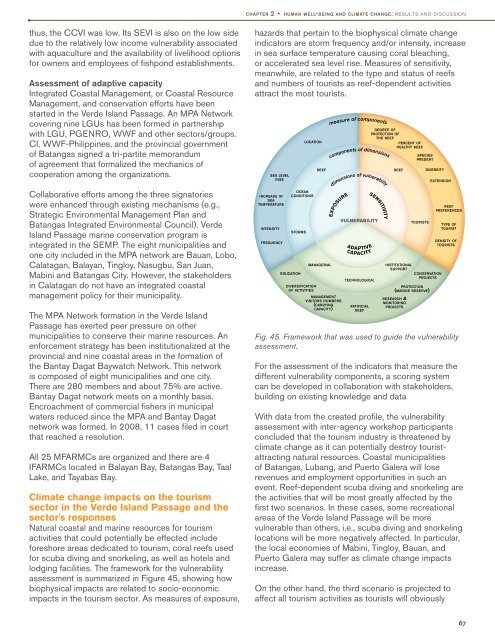of the Verde Island Passage, Philippines - weADAPT
of the Verde Island Passage, Philippines - weADAPT
of the Verde Island Passage, Philippines - weADAPT
You also want an ePaper? Increase the reach of your titles
YUMPU automatically turns print PDFs into web optimized ePapers that Google loves.
chapter 2 • human well-being and climate change: results and discussion<br />
thus, <strong>the</strong> CCVI was low. Its SEVI is also on <strong>the</strong> low side<br />
due to <strong>the</strong> relatively low income vulnerability associated<br />
with aquaculture and <strong>the</strong> availability <strong>of</strong> livelihood options<br />
for owners and employees <strong>of</strong> fishpond establishments.<br />
Assessment <strong>of</strong> adaptive capacity<br />
Integrated Coastal Management, or Coastal Resource<br />
Management, and conservation efforts have been<br />
started in <strong>the</strong> <strong>Verde</strong> <strong>Island</strong> <strong>Passage</strong>. An MPA Network<br />
covering nine LGUs has been formed in partnership<br />
with LGU, PGENRO, WWF and o<strong>the</strong>r sectors/groups.<br />
CI, WWF-<strong>Philippines</strong>, and <strong>the</strong> provincial government<br />
<strong>of</strong> Batangas signed a tri-partite memorandum<br />
<strong>of</strong> agreement that formalized <strong>the</strong> mechanics <strong>of</strong><br />
cooperation among <strong>the</strong> organizations.<br />
Collaborative efforts among <strong>the</strong> three signatories<br />
were enhanced through existing mechanisms (e.g.,<br />
Strategic Environmental Management Plan and<br />
Batangas Integrated Environmental Council). <strong>Verde</strong><br />
<strong>Island</strong> <strong>Passage</strong> marine conservation program is<br />
integrated in <strong>the</strong> SEMP. The eight municipalities and<br />
one city included in <strong>the</strong> MPA network are Bauan, Lobo,<br />
Calatagan, Balayan, Tingloy, Nasugbu, San Juan,<br />
Mabini and Batangas City. However, <strong>the</strong> stakeholders<br />
in Calatagan do not have an integrated coastal<br />
management policy for <strong>the</strong>ir municipality.<br />
The MPA Network formation in <strong>the</strong> <strong>Verde</strong> <strong>Island</strong><br />
<strong>Passage</strong> has exerted peer pressure on o<strong>the</strong>r<br />
municipalities to conserve <strong>the</strong>ir marine resources. An<br />
enforcement strategy has been institutionalized at <strong>the</strong><br />
provincial and nine coastal areas in <strong>the</strong> formation <strong>of</strong><br />
<strong>the</strong> Bantay Dagat Baywatch Network. This network<br />
is composed <strong>of</strong> eight municipalities and one city.<br />
There are 280 members and about 75% are active.<br />
Bantay Dagat network meets on a monthly basis.<br />
Encroachment <strong>of</strong> commercial fishers in municipal<br />
waters reduced since <strong>the</strong> MPA and Bantay Dagat<br />
network was formed. In 2008, 11 cases filed in court<br />
that reached a resolution.<br />
All 25 MFARMCs are organized and <strong>the</strong>re are 4<br />
IFARMCs located in Balayan Bay, Batangas Bay, Taal<br />
Lake, and Tayabas Bay.<br />
Climate change impacts on <strong>the</strong> tourism<br />
sector in <strong>the</strong> <strong>Verde</strong> <strong>Island</strong> <strong>Passage</strong> and <strong>the</strong><br />
sector's responses<br />
Natural coastal and marine resources for tourism<br />
activities that could potentially be effected include<br />
foreshore areas dedicated to tourism, coral reefs used<br />
for scuba diving and snorkeling, as well as hotels and<br />
lodging facilities. The framework for <strong>the</strong> vulnerability<br />
assessment is summarized in Figure 45, showing how<br />
biophysical impacts are related to socio-economic<br />
impacts in <strong>the</strong> tourism sector. As measures <strong>of</strong> exposure,<br />
hazards that pertain to <strong>the</strong> biophysical climate change<br />
indicators are storm frequency and/or intensity, increase<br />
in sea surface temperature causing coral bleaching,<br />
or accelerated sea level rise. Measures <strong>of</strong> sensitivity,<br />
meanwhile, are related to <strong>the</strong> type and status <strong>of</strong> reefs<br />
and numbers <strong>of</strong> tourists as reef-dependent activities<br />
attract <strong>the</strong> most tourists.<br />
SEA LEVEL<br />
RISE<br />
INCREASE IN<br />
SEA<br />
TEMPERATURE<br />
INTENSITY<br />
FREQUENCY<br />
OCEAN<br />
CONDITIONS<br />
STORMS<br />
EDUCATION<br />
LOCATION<br />
REEF<br />
MANAGERIAL<br />
measure <strong>of</strong> components<br />
components <strong>of</strong> dimensions<br />
dimensions <strong>of</strong> vulnerabiity<br />
EXPOSURE<br />
DIVERSIFICATION<br />
OF ACTIVITIES<br />
MANAGEMENT<br />
VISITORS NUMBERS<br />
(CARRYING<br />
CAPACITY)<br />
ADAPTIVE<br />
CAPACITY<br />
SENSITIVITY<br />
VULNERABILITY<br />
TECHNOLOGICAL<br />
ARTIFICIAL<br />
REEF<br />
DEGREE OF<br />
PROTECTION OF<br />
THE REEF<br />
PERCENT OF<br />
HEALTHY REEF<br />
Fig. 45. Framework that was used to guide <strong>the</strong> vulnerability<br />
assessment.<br />
For <strong>the</strong> assessment <strong>of</strong> <strong>the</strong> indicators that measure <strong>the</strong><br />
different vulnerability components, a scoring system<br />
can be developed in collaboration with stakeholders,<br />
building on existing knowledge and data<br />
With data from <strong>the</strong> created pr<strong>of</strong>ile, <strong>the</strong> vulnerability<br />
assessment with inter-agency workshop participants<br />
concluded that <strong>the</strong> tourism industry is threatened by<br />
climate change as it can potentially destroy touristattracting<br />
natural resources. Coastal municipalities<br />
<strong>of</strong> Batangas, Lubang, and Puerto Galera will lose<br />
revenues and employment opportunities in such an<br />
event. Reef-dependent scuba diving and snorkeling are<br />
<strong>the</strong> activities that will be most greatly affected by <strong>the</strong><br />
first two scenarios. In <strong>the</strong>se cases, some recreational<br />
areas <strong>of</strong> <strong>the</strong> <strong>Verde</strong> <strong>Island</strong> <strong>Passage</strong> will be more<br />
vulnerable than o<strong>the</strong>rs, i.e., scuba diving and snorkeling<br />
locations will be more negatively affected. In particular,<br />
<strong>the</strong> local economies <strong>of</strong> Mabini, Tingloy, Bauan, and<br />
Puerto Galera may suffer as climate change impacts<br />
increase.<br />
On <strong>the</strong> o<strong>the</strong>r hand, <strong>the</strong> third scenario is projected to<br />
affect all tourism activities as tourists will obviously<br />
REEF<br />
INSTITUTIONAL<br />
SUPPORT<br />
SPECIES<br />
PRESENT<br />
TOURISTS<br />
PROTECTION<br />
(MARINE RESERVE)<br />
RESEARCH &<br />
MONITORING<br />
PROJECTS<br />
DIVERSITY<br />
EXTENSION<br />
CONSERVATION<br />
PROJECTS<br />
REEF<br />
PREFERENCES<br />
TYPE OF<br />
TOURIST<br />
DENSITY OF<br />
TOURISTS<br />
67
















